| "The Adventure of the Speckled Band" | |||
|---|---|---|---|
| Short story by Sir Arthur Conan Doyle | |||
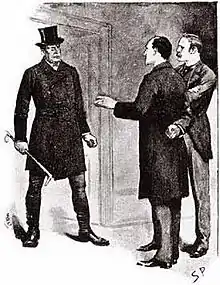 Dr. Roylott (left) confronts Holmes and Watson.
1892 illustration by Sidney Paget | |||
| Country | United Kingdom | ||
| Language | English | ||
| Genre(s) | Detective fiction short stories | ||
| Publication | |||
| Published in | The Strand Magazine | ||
| Published in English | February 1892 | ||
| Chronology | |||
| Series | The Adventures of Sherlock Holmes | ||
| |||
"The Adventure of the Speckled Band" is one of 56 short Sherlock Holmes stories written by Sir Arthur Conan Doyle, the eighth story of twelve in the collection The Adventures of Sherlock Holmes. It was originally published in Strand Magazine in February 1892.
"The Speckled Band" is a classic locked-room mystery that deals with the themes of parental greed, inheritance and freedom. Tinged with Gothic elements, it is considered by many to be one of Doyle's finest works, with the author himself calling it his best story.[1] The story, alongside the rest of the Sherlock Holmes canon, has become a defining part of detective fiction. It has been adapted for television, film, theatre, radio and a video game. It is part of the exhibit at the Sherlock Holmes Museum. The theatrical adaptation was written and produced by Doyle himself, directed by and starring Lyn Harding as Grimesby Roylott. The role of Holmes was played by H. A. Saintsbury. Doyle famously clashed with Harding over several details of the script, but later reconciled with him after the universal success of the play.[2]
Plot summary
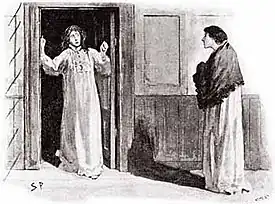
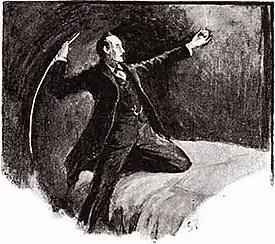
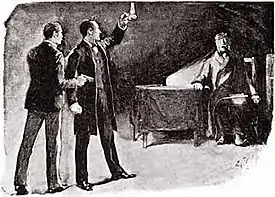
In April 1883, Sherlock Holmes and Dr. Watson rise early one morning to meet a young woman named Helen Stoner, who fears that her stepfather, Dr Grimesby Roylott, is threatening her life. She explains that Roylott is a violent doctor of great physical strength who practised in Calcutta, India; is the impoverished sole survivor of a wealthy but ill-tempered and amoral aristocratic Anglo-Saxon family in Surrey; and was married to Helen's late mother, a wealthy widow, 30 years prior. After serving time in an Indian prison for killing his Indian butler in a rage, Roylott had moved to England to reestablish his practice, but retired after his wife was killed in a railway accident eight years prior.
Furthermore, Helen's twin sister Julia died two years prior, shortly before her wedding day. Despite hearing her last words, "The speckled band!", Helen cannot make sense of them. Now that she is engaged, she has also begun hearing strange noises and observing strange activities around her heavily mortgaged countryside home of Stoke Moran, which Roylott has made extensive modifications to even before Julia's death. Of particular note, he is having an outside wall repaired, forcing Helen to move into the room where Julia died.
After Holmes agrees to take the case, he is visited by Roylott, who threatens him into reneging. Undaunted, Holmes leaves for the courthouse to examine Helen's mother's will before joining Watson in traveling to Stoke Moran, where he scrutinizes the premises. Within Helen's room, he discovers her bed is anchored to the floor, an unconnected bell cord was installed, and a ventilator hole connecting her room to Roylott's. Holmes and Watson arrange to stay the night in Helen's room.
At three a.m., a slight metallic noise and a dim light through the ventilator prompts Holmes to light a candle. He soon sees the "speckled band", a venomous snake, on the bell cord and strikes at it with his riding crop. Agitated, it flees back through the ventilator and kills Roylott, who had sent it to kill Helen and was awaiting its return. Holmes identifies the snake as an Indian swamp adder and reveals to Watson the will initially provided an annual income of £1,100 before dropping to £750 sterling when she died, of which her daughters could claim one-third upon marriage. Desiring all of the income for himself, Roylott schemed to murder his daughters. Though Holmes also admits to indirectly killing Roylott, he does not foresee it troubling him and chooses not to tell the police Roylott's full motive to spare Helen any further grief.
Inspirations
Richard Lancelyn Green, the editor of the 2000 Oxford paperback edition of The Adventures of Sherlock Holmes, surmises that Doyle's source for the story appears to have been the article named "Called on by a Boa Constrictor. A West African Adventure" in Cassell's Saturday Journal, published in February 1891.[1] In the article, a captain tells how he was dispatched to a remote camp in West Africa to stay in a tumbledown cabin that belonged to a Portuguese trader. On the first night in the cabin, he is awoken by a creaking sound, and sees "a dark queer-looking thing hanging down through the ventilator above it". It turns out to be the largest Boa constrictor he has seen (more likely a python because there are no boas in Africa). He is paralysed with fear as the serpent comes down into the room. Unable to cry out for help, the captain spots an old bell that hung from a projecting beam above one of the windows. The bell cord had rotted away, but by means of a stick he manages to ring it and raise the alarm.
Identity of 'the speckled band'
"It is a swamp adder!" cried Holmes; "the deadliest snake in India. He has died within ten seconds of being bitten."
Most people consider the snake to be a fictitious creation; however, the identity of the snake has been a subject of much debate among Sherlockians.
The key characteristics to be considered in identification of the snake are:
- A fast-acting neurotoxic venom, as opposed to the common haemotoxic venom of most snakes
- Ability to climb well
- Appearance described as a "yellow band with brownish speckles", a "squat, diamond-shaped" head, and a "puffed" neck
- An Indian origin[3]
The below candidates have been considered.
| Snake | Characteristics | Considered in: |
|---|---|---|
| Puff adder |
|
Catalogue of the 1951 Sherlock Holmes Exhibition |
| River-jack |
|
Catalogue of the 1951 Sherlock Holmes Exhibition |
| Russell's viper |
|
Catalogue of the 1951 Sherlock Holmes Exhibition |
| Saw scaled viper |
|
Catalogue of the 1951 Sherlock Holmes Exhibition |
| Temple viper |
|
Catalogue of the 1951 Sherlock Holmes Exhibition |
| Burmese krait or Spotted Krait |
|
Catalogue of the 1951 Sherlock Holmes Exhibition |
| Cobra |
|
Catalogue of the 1951 Sherlock Holmes Exhibition |
| Skink
(A lizard of the family Scincidae) |
specially bred by Roylott to obtain rapid-acting venom and desired behaviour | "The Truth About the Speckled Band", by Lawrence M. Klauber |
| Gila monster | specially bred by Roylott to obtain rapid-acting venom and desired behaviour | "Leapin' lizards: An Irregular and Unnatural History of the Speckled Band", by Warren Randall |
| Boa constrictor or choke snake | only analyses characteristic movement | "De Vergissing van Sherlock Holmes"
(Sherlock Holmes' error) |
| Inland Taipan |
|
"A Fresh Bite at The Speckled Band", by Philip Cornell |
Source: The New Annotated Sherlock Holmes by Leslie S Klinger
Publication history
"The Adventure of the Speckled Band" was first published in the UK in The Strand Magazine in February 1892, and in the United States in the US edition of the Strand in March 1892.[4] The story was published with nine illustrations by Sidney Paget in The Strand Magazine.[5] It was included in the short story collection The Adventures of Sherlock Holmes,[5] which was published in October 1892.[6]
Adaptations
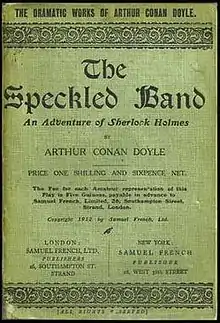
Theatre
- Conan Doyle wrote an adaptation for the stage in 1910, The Speckled Band.[7] It premiered at the Adelphi Theatre, London, on 4 June 1910, under the name The Stonor Case.
- In autumn 2013, a new stage adaptation, Sherlock Holmes and the Speckled Band, by Max Gee premiered at Treasurer's House, York and Ripley Castle, Ripley, North Yorks. The play was produced by Theatre Mill, directed by Samuel Wood, and starred Liam Tims as Holmes and Adam Elms as Watson.[8]
Film
- The short story was also adapted for the now-lost 1912 British–French short film The Speckled Band as part of the Éclair film series featuring Georges Tréville as Sherlock Holmes.[9][10]
- A 1923 silent short film was adapted in the Stoll film series starring Eille Norwood as Holmes.[11]
- The 1931 film The Speckled Band, starring Raymond Massey as the detective, was an adaptation of Conan Doyle's stage play, with Lyn Harding reprising his role as Grimesby Roylott.[12]
- The 1944 film The Spider Woman is based on several Holmes stories, among them "The Speckled Band".[13]
Radio and audio dramas
- The premiere episode of The Adventures of Sherlock Holmes featured an adaptation of the story on 20 October 1930 and starred William Gillette as Holmes and Leigh Lovell as Watson.[14] The production was adapted by Edith Meiser. A remake of the script aired on 17 September 1931, with Richard Gordon playing Sherlock Holmes and Leigh Lovell again playing Dr. Watson.[15] Another dramatisation of the story aired in February 1933 with Gordon and Lovell, though it is unclear if this was a repeated recording or a new production.[16] A remake of the script aired on 1 February 1936, with Gordon as Holmes and Harry West as Watson.[17]
- A half-hour radio adaptation starring Basil Rathbone and Nigel Bruce was broadcast as an episode of the series The New Adventures of Sherlock Holmes on 16 October 1939, again adapted by Edith Meiser.[18] Other episodes adapted from the story also aired in March 1941,[19] October 1943,[20] and November 1945, again with Rathbone and Bruce playing Holmes and Watson respectively.[21][22] A half-hour radio adaptation starring Tom Conway as Holmes and Bruce as Watson was broadcast on 23 June 1947.[23][24] A half-hour radio adaptation starring John Stanley as Holmes and Wendell Holmes (using the pseudonym "George Spelvin") as Watson aired as an episode of the same series on 19 December 1948, and was adapted by Max Ehrlich.[25][26]
- A 1945 BBC Home Service adaptation, dramatised by John Dickson Carr, starred Cedric Hardwicke as Holmes and Finlay Currie as Watson.[27]
- A 1948 radio adaptation on the Home Service, also adapted by John Dickson Carr, featured Howard Marion-Crawford as Holmes, with Finlay Currie again playing Watson.[27] Howard Marion-Crawford later played Watson in the 1954–1955 television series Sherlock Holmes.
- A radio adaptation with John Gielgud as Holmes and Ralph Richardson as Watson aired in 1955 on NBC radio.[28]
- A half-hour BBC radio adaptation was broadcast in July 1962 on the BBC Light Programme, as part of the 1952–1969 radio series starring Carleton Hobbs as Holmes and Norman Shelley as Watson. Michael Hardwick adapted the production.[29]
- In 1970, an audio drama based on the story was released on LP record, as one of several recordings starring Robert Hardy as Holmes and Nigel Stock as Watson. It was dramatised and produced by Michael Hardwick (who also adapted the 1962 radio adaptation) and Mollie Hardwick.[30]
- A one-hour radio adaptation was broadcast as an episode of the series CBS Radio Mystery Theater on 28 June 1977.[31] The episode starred Kevin McCarthy as Sherlock Holmes and Court Benson as Dr. Watson.[32]
- A BBC Radio 4 dramatisation adapted by Vincent McInerney aired on 9 January 1991, as part of the 1989–1998 radio series starring Clive Merrison as Holmes and Michael Williams as Watson. It also featured Susan Wooldridge as Helen Stoner.[33]
- In June 2011 Big Finish Productions produced a reading of the story as Sherlock Holmes: The Speckled Band starring Nicholas Briggs as Sherlock Holmes and Richard Earl as Dr. Watson.[34]
- The story was adapted as a 2015 episode of the radio series The Classic Adventures of Sherlock Holmes, with John Patrick Lowrie as Holmes and Lawrence Albert as Watson.[35]
- A one-hour Bengali adaptation by Radio Mirchi, Kolkata starring Mir Afsar Ali broadcast as an episode of Sunday Suspense on 1 May 2016.
Television
- A half-hour television adaptation starring Alan Napier and Melville Cooper was broadcast as the tenth episode of the NBC Television series Your Show Time on 25 March 1949.[36] This is one of the earliest known television appearances of Holmes.
- The pilot episode of the BBC's 1964–1965 series Sherlock Holmes was a new version of "The Speckled Band", airing in May 1964 as part of the Detective anthology series. The episode was written by Giles Cooper, was directed by Robin Midgley, and starred Douglas Wilmer as Holmes, Nigel Stock as Watson and Felix Felton as Roylott.[37]
- "The Speckled Band" was adapted for the screen in the USSR in 1979 with Vasily Livanov as Sherlock Holmes and Vitaly Solomin as Doctor Watson.
- "The Speckled Band" was the sixth episode of the first series of Holmes adaptations by Granada Television starring Jeremy Brett as Holmes and David Burke as Watson, first broadcast in 1984.[38]
- "The Speckled Band" was adapted as part of the 1984–85 anime series Sherlock Hound. In this version, Moriarty poses as Roylott to steal Helen's money, and Hound gets involved when his motorcar breaks down and must stay at their home for the night.
- Kōki Mitani adapted "The Adventure of the Speckled Band" and "The Creeping Man" to an episode in the NHK puppetry series Sherlock Holmes. One night a swamp adder with crocus-shaped speckles is found in Beeton School. On the next day, trainee teacher Helen Stoner visits Holmes and Watson in 221B of Baker Dormitory and tells them about the strange behaviour of Grimesby Roylott who teaches chemistry. That night they find out what his behaviour means but Sherman, a female pupil is attacked by the adder.[39]
- The animated television series Sherlock Holmes in the 22nd Century featured an adaptation of the story, "The Scales of Justice".
Video games
- The Great Ace Attorney: Adventures adapted "The Speckled Band" into the game's second episode, "The Adventure of the Unbreakable Speckled Band". In the episode, the protagonist, Ryunosuke Naruhodo, aids Herlock Sholmes (named "Sherlock Holmes" in the original Japanese released; changed in localisation for legal reasons) in the investigation, the protagonist's best friend, Kazuma Asogi, takes the place as the victim, and the culprit's true identity is changed to a Russian asylum seeker who was only going by the alias of Roylott to hide her identity. In the middle of the case, Sholmes deduces the story's original conclusion. However, Ryunosuke's partner, Susato Mikotoba, points out the numerous issues regarding the biology of snakes. Thanks to Ryunosuke, it is eventually deduced that the victim's death was caused by him tripping over a cat after being shoved, breaking his neck on a bedpost, and that the "speckled band" refers to a cat teaser toy. Later in the game's fourth episode; "The Adventure of the Clouded Kokoro," Herlock's assistant, Iris Wilson, adapts the events into "The Speckled Band", but changes some details around to make it more interesting to the audience such as by making the snake the murder weapon, fully aware that this wouldn't make sense considering the biology of snakes.
References
- Notes
- 1 2 Green, Richard Lancelyn (1998). "Explanatory Notes". The Adventures of Sherlock Holmes. Oxford University Press. pp. 361–367. ISBN 0-19-283508-4.
- ↑ "From Holmes to Sherlock: The Story of the Men and Women Who Created an Icon". 13 March 2017. Retrieved 2 January 2019.
- ↑ Klinger, Leslie. The New Annotated Sherlock Holmes. W. W. Norton & Company. pp. 200–300.
- ↑ Smith (2014), p. 56.
- 1 2 Cawthorne (2011), p. 66.
- ↑ Cawthorne (2011), p. 54.
- ↑ Boström, Mattias (2018). From Holmes to Sherlock. Mysterious Press. pp. 147–148. ISBN 978-0-8021-2789-1.
- ↑ Hickling, Alfred (18 November 2013). "Sherlock Holmes and the Speckled Band – review". The Guardian. Retrieved 1 January 2019.
- ↑ Eyles, Allen (1986). Sherlock Holmes: A Centenary Celebration. Harper & Row. p. 130. ISBN 9780060156206.
- ↑ "The Speckled Band". silentera.com. Retrieved 8 March 2013.
- ↑ Eyles, Alan (1986). Sherlock Holmes: A Centenary Celebration. Harper & Row. pp. 132. ISBN 0-06-015620-1.
- ↑ Bunson, Matthew (1997). Encyclopedia Sherlockiana: an A-to-Z guide to the world of the great detective. Macmillan. p. 247. ISBN 0-02-861679-0.
- ↑ Barnes, Alan (2002). Sherlock Holmes on Screen. Reynolds & Hearn Ltd. p. 198. ISBN 1-903111-04-8.
- ↑ Boström, Mattias (2018). From Holmes to Sherlock. Mysterious Press. pp. 196–199. ISBN 978-0-8021-2789-1.
- ↑ Dickerson (2019), pp. 31, 39.
- ↑ Dickerson (2019), p. 50.
- ↑ Dickerson (2019), p. 72.
- ↑ Dickerson (2019), p. 87.
- ↑ Dickerson (2019), p. 97.
- ↑ Dickerson (2019), p. 131.
- ↑ Dickerson (2019), p. 183.
- ↑ "Sherlock Holmes OTR - Basil Rathbone and Nigel Bruce (January 9, 2014)". Internet Archive. 9 January 2014. Retrieved 31 December 2014.
- ↑ Dickerson (2019), p. 230.
- ↑ "Sherlock Holmes Tom Conway". Internet Archive. Retrieved 31 December 2014.
- ↑ Dickerson (2019), p. 266.
- ↑ "Sherlock Holmes 1948-12-19 The Speckled Band". Internet Archive. Retrieved 31 December 2014.
- 1 2 De Waal, Ronald Burt (1974). The World Bibliography of Sherlock Holmes. Bramhall House. p. 382. ISBN 0-517-217597.
- ↑ Dickerson (2019), p. 286.
- ↑ De Waal, Ronald Burt (1974). The World Bibliography of Sherlock Holmes. Bramhall House. p. 388. ISBN 0-517-217597.
- ↑ De Waal, Ronald Burt (1974). The World Bibliography of Sherlock Holmes. Bramhall House. p. 411–412. ISBN 0-517-217597.
- ↑ "CBS Radio Mystery Theater 1977-1978". Internet Archive. Retrieved 31 December 2014.
- ↑ Payton, Gordon; Grams, Martin Jr. (2015) [1999]. The CBS Radio Mystery Theater: An Episode Guide and Handbook to Nine Years of Broadcasting, 1974-1982 (Reprinted ed.). McFarland. p. 214. ISBN 9780786492282.
- ↑ Bert Coules. "The Adventures of Sherlock Holmes". The BBC complete audio Sherlock Holmes. Retrieved 12 December 2016.
- ↑ "Sherlock Holmes: The Speckled Band". Retrieved 29 May 2020.
- ↑ Wright, Stewart (30 April 2019). "The Classic Adventures of Sherlock Holmes: Broadcast Log" (PDF). Old-Time Radio. Retrieved 14 June 2020.
- ↑ Barnes, Alan (2011). Sherlock Holmes on Screen. Titan Books. p. 311. ISBN 9780857687760.
- ↑ Alan Barnes (2002). Sherlock Holmes on Screen. Reynolds & Hearn Ltd. pp. 138–143. ISBN 1-903111-04-8.
- ↑ Eyles, Allen (1986). Sherlock Holmes: A Centenary Celebration. Harper & Row. p. 140. ISBN 9780060156206.
- ↑ Shinjiro Okazaki and Kenichi Fujita (ed.), "シャーロックホームズ冒険ファンブック Shârokku Hômuzu Boken Fan Bukku", Tokyo: Shogakukan, 2014, pp. 46-48, p. 53 and pp. 82-83.(Guidebook to the show)
- Sources
- Cawthorne, Nigel (2011). A Brief History of Sherlock Holmes. Running Press. ISBN 978-0762444083.
- Dickerson, Ian (2019). Sherlock Holmes and His Adventures on American Radio. BearManor Media. ISBN 978-1629335087.
- Smith, Daniel (2014) [2009]. The Sherlock Holmes Companion: An Elementary Guide (Updated ed.). Aurum Press. ISBN 978-1-78131-404-3.
External links
 The full text of The Adventure of the Speckled Band at Wikisource
The full text of The Adventure of the Speckled Band at Wikisource Media related to The Speckled Band at Wikimedia Commons
Media related to The Speckled Band at Wikimedia Commons- The Adventures of Sherlock Holmes, including The Adventure of the Speckled Band at Standard Ebooks
- "The Adventure of the Speckled Band" at Google Books
 The Adventure of the Speckled Band public domain audiobook at LibriVox
The Adventure of the Speckled Band public domain audiobook at LibriVox- The full text of The Adventure of the Speckled Band at the Internet Archive